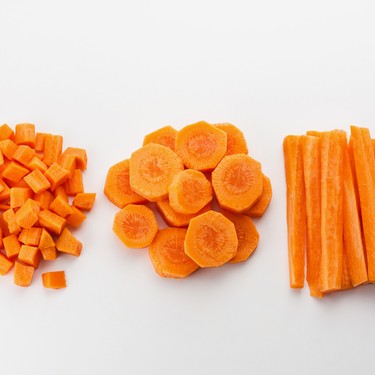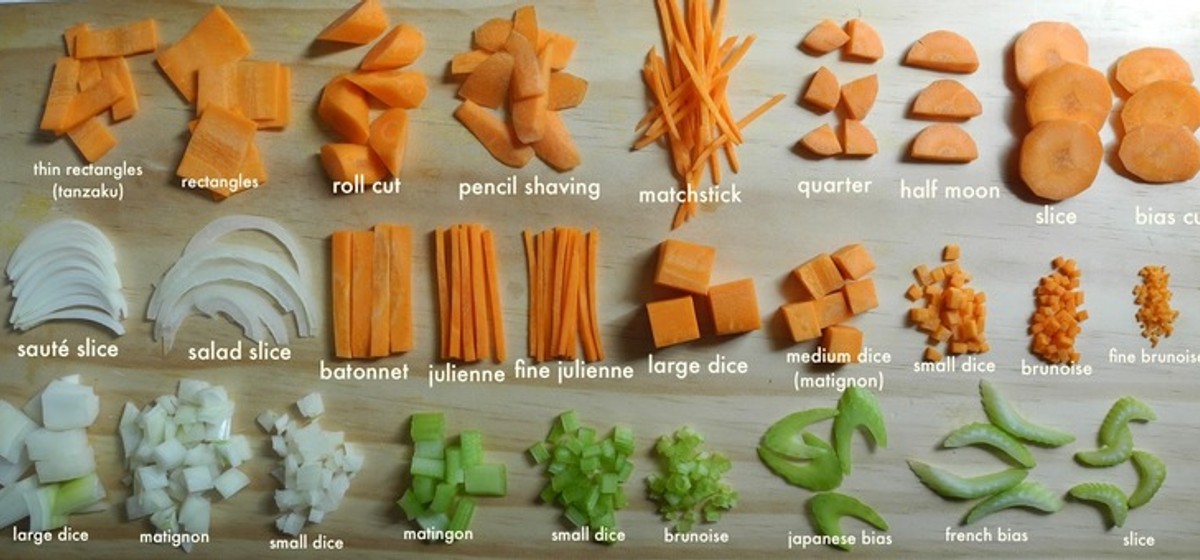Knife Skills 101




To make the game-winning shot, you have to have a fully inflated ball (unless you’re Tom Brady). To make the perfect putt, you need a strong driver. The kitchen is no different. To create an impressive and memorable meal, you need the right knives.
However, a good knife is simply an extension of the person behind it. In other words, you may have the fastest car in the world, but unless you know how to handle it, you aren’t going to win the Grand Prix.
Alex Xu, a trained chef, gave us the lowdown on the best knives and cuts you need to slay in the kitchen.
I grew up surrounded by men who are excellent home cooks; my grandfathers and my uncles are all great cooks. My memories of family reunions are of all the men working throughout the day to get a big meal out for the family. At first, I wanted to learn how to cook because I wanted to be one of the guys. Food was always what brought my family together, and it became my passion from then on.
I went to culinary school between high school in college, and I worked in fine dining restaurants after that. All in all, I’ve been cooking professionally for 4 years. There are few things in this world that can bring people together and create bonds like a shared meal. In my family, cooking for one another is our way of loving and caring for one another. In that way, I want to make good food that makes people happy.
If you live in the States, three great resources are Korin, Japanese Knife Imports, and Chef Knives to Go. These websites have a selection anywhere from cheap, entry-level workhorse knives to super expensive one-off bespoke masterpieces. Knives can be objectively “good," that is, well-made, and also good for you, how the knife fits your hand and your technique. First, a well-made knife will have no fit and finish issues, which means that all parts of the knife should be assembled seamlessly. No gaps should be seen between bolster and blade, no epoxy or glue should be showing, and the blade should be straight.
Then it comes down to steel type and heat treatment, which determines a knife’s hardness, cutting ability and edge retention. I dislike German knives because they’re generally heat-treated in a way that makes the steel very soft, which means it goes dull very quickly. You’re looking for something in the 59-61 range on the Rockwell hardness scale, which will be a good balance between edge retention and ease of sharpening. Not all steel is created equal, there are many types of carbon steel, most of which have great edge retention, but can rust if you don’t have good habits. In the stainless realm, look for Ginsan or Silver-3 steel, which is my favorite, AEB-L is a close second, and VG10 can also be decent depending on the maker. I also prefer Japanese knives for their profile. With a much less pronounced belly (that is, the curve from tip to heel), this style of knife is much better suited to the French technique that I learned.
If you enter the best (Western) kitchens in the world, it’s likely you will see a lot of Misono UX10’s in the hands of the line cooks. Line cooks aren’t the world’s best paid workers, so it’s important to them that their money goes a long way. Misono makes great knives across the board, but the UX10 in particular is thin but very tough and keeps a sharp edge for a long time.
Masamoto would be my second choice behind Misono, and the Mac professional line and Global are also good quality for a standard chef’s knife. Stay away from Shun, they are mass-produced knives with mediocre steel and bad heat treatment. For the same price, one can buy a much, much better knife.
If traveling is within your budget, definitely go to Japan and visit some of those blacksmiths whose families have been making knives for 2 or 3 generations. Also, Masamoto Tsukiji in Tokyo, Kamata in Tokyo, and Aritsugu in Kyoto are great knife specialty stores. If not, the websites mentioned earlier have an incredible selection of knives that are made by nationally recognized knife smiths that are either custom or one off.
Japanese waterstones can be purchased on Amazon or any of the above websites. For beginners, I’d recommend starting with 1000 and 6000 grit waterstones while you hone your technique. Jon Broida, the owner of Japanese Knife Imports in LA, has many detailed tutorial videos available online. One of the biggest misconceptions out there is that the steel rod that comes with a knife set is used to sharpen. The honing rod doesn't actually sharpen a knife - it only hones the edge, which basically means it keeps the edge straight.
I use a paring knife mainly for two tasks: for trimming and peeling small fruits and vegetables, as well as when I’m breaking down or deboning chicken and I use the back of the knife to scrape meat off of the bones.
Slicing and dicing is a common colloquialism for a reason. Macedoine and brunoise are the fancy French names for medium and small dice, and these two make up the bases for many stocks, sauces, purees and the list goes on. Batonnet and julienne are medium and narrow matchsticks, useful for garnishing, but also important as they are one step back from proper macedoine and brunoise. If your matchsticks are of uneven width or aren't straight, then your dice will be uneven or crooked. If you master the macedoine and brunoise, you can tackle any other knife cut out there.

A good grip and technique will help immeasurably. Pinch the end of the blade with your thumb and forefinger, keeping your last three fingers wrapped lightly around the handle. Keep your knife in line with your forearm, push and pull the knife primarily with your big muscles - your shoulder, arm and elbow - this will keep your motion more steady and consistent.

Uniform cuts ensure things cook at the same rate, and evenly. You don't want one piece of carrot, meat, or whatever you're cooking perfect and another totally raw! It's worth practicing your knife skills; you'll look like a total badass if you can fly through an onion or carrot, leaving a perfect tiny dice. It'll also help you make tastier and properly cooked food.
Let's put it this way, dull knives take more effort to cut, and will easily slide off the side of the onion, carrot, or chicken that you're cutting, right into your poor hand that is keeping things steady. A sharp knife will cut with less effort, and if you do catch your fingers, the cut will be much cleaner and you'll feel it more immediately, which will help you avoid a deeper cut. Cutting yourself with a dull knife will tear and rip instead of cut cleanly, and you can imagine how that feels.
A good knife block or even a knife roll is best for storage. Those magnetic strips people mount on walls frighten me and seem very hard on knives, as they’re quite hard.
I arrived at work one morning after attending a concert, having forgotten to take off the light-up bracelets that I’d received for the concert the evening before. My cooks thought it would be funny to film me cutting onions with the bracelet on.
Get ready to put your new knife skills into use and check back in for new content daily!